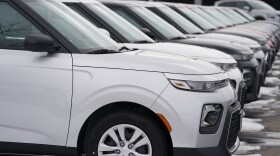The latest state greenhouse gas report projects that Hawaiʻi will miss its next major emission reduction targets. Transportation is the largest source of the state's emissions, and the Hawaiʻi Department of Transportation is preparing to release a strategy for reducing greenhouse gases from its systems.
The report, prepared by the state Department of Health, concludes that based on emission data from 2022, the state is off-track on two important goals: slashing emissions in half by 2030 compared to 2005 levels, and eliminating emissions entirely by 2045.
The transportation sector, which encompasses ground, marine, and air travel, is responsible for about half of the state's total emissions. Getting fossil fuels out of transportation is a serious hurdle in the state's transition to a carbon-free economy.
"Unless we make a real big change, there really won't be a dramatic drop in emissions, and we won't be able to make our state climate goals," said Laura Kaʻakua, HDOT's climate and culture manager.

Over the last year, the Hawaiʻi Department of Transportation has been working on an emissions reduction strategy, one of the requirements of a landmark settlement agreement the state reached with a group of youth plaintiffs last summer who claimed the state hadn't done enough to reduce climate pollution from the transportation sector.
Some of those plaintiffs are now involved in the development of HDOT's greenhouse gas reduction plan.
A draft plan will be released detailing specific actions on June 10. Kaʻakua said it involves significant investments in public transportation options in each of the counties. It is also reliant on carbon offsets and the widespread adoption of sustainable aviation fuel.
In order for the plan to be successfully implemented, Kaʻakua said buy-in is needed from a broad range of stakeholders, including the public.
"It really includes everyone who touches transportation, which is really everyone in Hawaiʻi," she said.
With an all-hands-on-deck effort, Kaʻakua said there is a possible path to cutting nearly all greenhouse gas emissions from transportation in time for the state's 2045 deadline.
But the 2030 milestone of reducing emissions by 50% may be out of reach.
Kaʻakua said the main culprit is pollution from air travel. Electrified aviation is still in its infancy, and while HDOT does anticipate an uptake of sustainable aviation fuels across the airline industry, it won't be in time for Hawaiʻi to meet its 2030 target.
When asked if that would pose a problem for the state's settlement agreement with the young plaintiffs, Kaʻakua said no.
"What we're required to do is take all actions possible," she said. "So the focus is, 'Okay, we have to start somewhere, right?' We have to get as close as we can."
Hawaiʻi Public Radio exists to serve all of Hawai‘i, and it's the people of Hawai‘i who keep us independent and strong. Help keep us strong to serve you in the future. Donate today.






